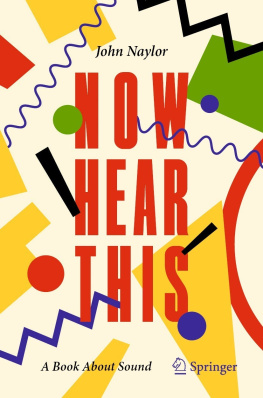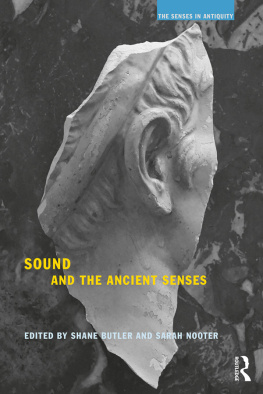
Copyright 2012 by Seth S. Horowitz
Electronic edition published in September 2012
Published by Bloomsbury USA, New York
All rights reserved. No part of this book may be used or reproduced in any manner whatsoever without written permission from the publisher except in the case of brief quotations embodied in critical articles or reviews.
For information address Bloomsbury USA,
175 Fifth Avenue, New York, NY 10010.
LIBRARY OF CONGRESS CATALOGING-IN-PUBLICATION DATA
Horowitz, Seth S.
The universal sense : how hearing shapes the mind / Seth S. Horowitz.
p. cm.
1. HearingPhysiological aspects. 2. SoundPsychological
aspects. I. Title.
QP461.H594 2012
612.85dc23
2012009642
First U.S. edition 2012
eISBN: 978-1-60819-884-9
www.bloomsburyusa.com
For China Blue and Lance,
partners in acoustic crime
and
Arnold Horowitz,
for late-night weird ideas
A first book is a very hard thing to write, especially when it involves something you feel passionate about. It requires bringing together elements scattered over decades of experience and interactions with a huge number of people, places, and things, living and otherwise. Writing about things heard is particularly difficult because so much of the inner life of sound dwells below conscious thought. At first thought, it seems easymany of the sounds we pay attention to in daily life are words. You can transcribe conversations or lyrics into written form in a straightforward fashion because words are bound by the conventions of language. But go a bit below the basics of the written and spoken word and you find that the rules of written language only give you a piece of the richness found even in plain speech of a nontonal language such as English. If I write What? you, as the reader, understand that I asked a question. But imagine hearing me yell it (WHAT!!!!). Suddenly there is an entirely new context based on how I changed the soundyou are interrupting me, Im angry or impatient, or you just gave me really bad news and Im questioning the reality of what you just said. Or if I say it very quietly after a long pause ( what?), have you just given me really bad news? Just by changing the sound of a simple word, you gain insight into the emotional, attentional, and behavioral state of both the speaker and the listener. While you can describe the sound of a contented cat as a purr, how can you explain how it induces a feeling of calm in its owner or frustration in a person who has become the object of said purrboxs affections despite a massive allergy to felines? Trying to explain these reactions requires forays into amplitude modulation, interspecies communication, and the emotional function of the brain, both human and feline. And what about the squirm-inducing sound of fingernails ratcheting down a blackboard? Why would we have evolved such a visceral response to a very specific behavior that uses a piece of technology that was only invented in 1815?
The way sounds are made and heard (or not), the effects sounds have on your mind, your emotions, your attention, your memories, your moods, are so vast as to be almost beyond description. There are literally hundreds of excellent (and some not so excellent) books covering individual pieces of this vast puzzle. Yet at the heart of all sound, its perception and effects on living things, lies a mathematical heart that ties together the most basic interactions of matter, energy and the mind.
I decided to write this book because for more than thirty years I have been fascinated by all types of sounds. Sound has held my attention and my passion as I have tried to understand it from a variety of different perspectivesfrom R&B musician to digital sound programmer, dolphin trainer to auditory neuroscientist, music producer to sonic branding designerand to integrate it into a single theme: how sound and hearing have shaped the evolution, development, and day-to-day function of the mind.
A couple of words about why this book may be different from other books youve read on sound. Most recent science-related works about sound and its various children such as speech, music, and noise are based on neural imaging studies. Techniques such as functional magnetic resonance imaging (fMRI) create beautiful images of what part of the brain is active when listening to, looking at, or thinking about certain things. For the most part these studies focus on the cortex, the huge convoluted volume of brain that is characteristic of humans and other big-brained mammals such as dolphins and chimps, and hence is whats called top-downyou look at the areas that are involved in the final processing steps for the activity youre interested in. My take on things is based on how things start in the outside world and work their way in, from the first physical sensations in the ear (and occasionally other sensors) through the lowest parts of the brainstem. My perspective is bottom-up, focusing on elements that underlie and drive high-level cortical and cognitive functions. Both perspectives are critical in science, but to me the bottom-up approach gives a more intimate understanding of the umwelt, the world built from your senses. To me (and I hope to you after reading this book), this gives one brain a better chance of understanding the deep processes of another brain in the context of the ever-changing world in which we are embedded.
As with all projects that try to take a broad view of large things, many fine features will get lost in the mix. This book will not be a textbook on auditory neuroscience and perception, but I will try to explain my wonder at how cells a few tens of microns long, working on the picovolt scale and opening and closing molecular channels thousands of times per second, underlie your recognition of your mothers voice. This book will not give any ultimate answer to the biological basis of appreciation of music, but it will try to explain why science has such a rough time addressing this type of basic human behavior. Likewise, it will not tell you how to become an award-winning sound engineer, but it might explain why you really shouldnt shell out any money for ringtones that are supposed to make you irresistible to the opposite sex or drive teenagers off your lawn. And while it wont be able to explain the choices of filmmakers who insist on inserting explosion sounds in outer-space battle scenes, it will take you on an acoustic tour of places beyond Earth in the hopes that some young readers will actually get the chance to hear the winds of Mars for themselves, and perhaps remember that they read it here first.
It has been more than thirty years since I first thought about writing a book about sound, and if I waited another thirty, I still wouldnt have the whole storyand I would have even more seriously blown my deadline getting this to my very patient editor, Benjamin Adams. But in those thirty years, I have been blessed with a wide cast of teachers, supporters, colleagues, and friends who have shared and shaped my passion for sound and listening. The short list includes the late Gerald Soffen, former NASA director of life sciences, who first sparked my interest in astrobiology (and was the first to ask me what I thought Mars would sound like). Martha Hiatt of the New York Aquarium was the first person to ever successfully teach me patience by holding out the carrot of letting me work with and learn from Lily, Starkey, and Mimi, the dolphins who inspired my love of animal behavior. Peter Moller of Hunter College tricked me into loving psychology research and introduced me to the world of neuroethology, as well as suggesting that I follow it as a career, starting at Brown University. There I met my advisor, Andrea Megela Simmons, and my postdoctoral advisor, James Simmons, as well as some amazing teachers and students who became colleagues, including Sharon Swartz, Barry Connors, David Berson, Diane Lipscombe, Judith Chapman, Rebecca Brown, Mary Bates, Jeffrey Knowles, and others too numerous for my page limits. Peter Schultz, friend, scientific provocateur, and director of the NASA Rhode Island Space Grant, has encouraged and helped fund some of my strangest projects. The late, great, and much missed Ed Mullen, the engineer extraordinaire who dubbed me Dr. Evil for my interest in the weirdest things ever built in the name of science (e.g., a bat-mounted laser pack), helped me carry out some of my most fun studies. Rachel Herz, fellow sufferer of nonsense at Brown and author of
Next page








